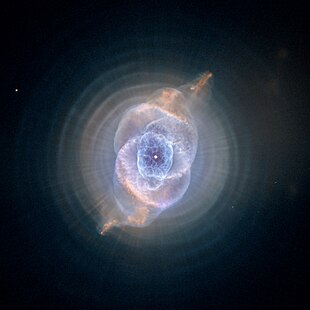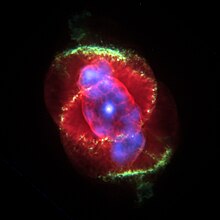Cat's Eye Nebula
|
Planetary Nebula Data of the Cat's Eye Nebula |
|
|---|---|

|
|
| Image of the HST of the area around the nebula, one recognizes the spheres emitted at intervals of about 1500 years | |
| AladinLite | |
| Constellation | Dragon |
|
Position equinox : J2000.0 |
|
| Right ascension | 17h 58m 33.4s |
| declination | + 66 ° 37 ′ 59 ″ |
| Appearance | |
| Apparent brightness (visual) | 8.1 likes |
| Apparent brightness (B-band) | 8.8 likes |
| Angular expansion | 6.4 ′ × 0.3 ′ |
| Central star | |
| designation | HD 164963 |
| Apparent brightness | ≈ 20 mag |
| Spectral class | Pd |
| Physical data | |
| Redshift | (−219 ± 3) · 10 −6 |
| Radial velocity | (−65.7 ± 0.9) km / s |
| distance | 3300 ly |
| history | |
| discovery | Wilhelm Herschel |
| Date of discovery | February 15, 1786 |
| Catalog names | |
| NGC 6543 • PK 096 + 29.1 • GC 4373 • 2MASS X J17583335 + 6637591 • H IV 37 star: HD 164963 • BD +66 1066 • TYC 4212-508-1 |
|
The Cat's Eye Nebula ( NGC 6543 ) is a planetary nebula in the constellation Dragon . Structurally it is one of the most complex of the known nebulae. High-resolution images from the Hubble Space Telescope revealed extraordinary structures such as nodes, jets and arch-like features. Visually, it is similar to the cat's eye and was named accordingly.
It was discovered by Wilhelm Herschel on February 15, 1786 and was the first planetary nebula whose spectrum was investigated (by the amateur astronomer William Huggins in 1864).
General information
NGC 6543 is a very carefully studied planetary nebula. It has a magnitude of 8.1 and is therefore invisible to the naked eye. But it has a very high surface brightness . Its right ascension is 17h 58.6m and its declination is 66 ° 38 ′. Its high declination means that it can be easily observed from the northern hemisphere , which is where most of the large telescopes are located. NGC 6543 is located almost at the north pole of Earth's orbit and is therefore also known by the older name of the Ecliptic North Pole Nebula .
While the diameter of the bright inner part is very small, about 20 arc seconds , there is also a 6.4 arc-minute halo around the nebula that was ejected from its old star when it was a red giant.
The main body has a density of about 5,000 particles per cubic centimeter and a temperature of about 8,000 K . The outer halo has a temperature of 15,000 K and a much lower density.
The central star is an O-type star and has a temperature of 80,000 K. It appears about 10,000 times brighter than our sun, but has a radius of only 0.65 times that of our sun.
Through spectroscopic analysis it was shown that he is currently mass by its fast stellar wind loses. It is roughly 3.2 × 10 −7 solar masses a year - 20 trillion tons per second. The wind speed is 1900 km / s. Calculations showed that the stellar mass is only a little more than one solar mass, but the calculations assume that it originally had 5 solar masses.
observation
The nebula was discovered on February 15, 1786 by Wilhelm Herschel and was the first planetary nebula in which the spectrum was examined by the amateur astronomer William Huggins in 1864. Huggins' observations were the first to suggest that it was made up of extremely dilute gas. Since these early observations, NGC 6543 has been studied across the electromagnetic spectrum .
Infrared observations
Observations at NGC 6543 in the infrared range show that there is interstellar dust in low temperature regions. It is believed to have formed in the final phase of the original central star. The dust absorbs light from the central star and converts it into infrared light. From the infrared spectrum of the dust it has been calculated that it has a temperature of around 70 K.
Infrared emissions also indicated the existence of non-ionized material such as molecular hydrogen (H 2 ). In many planetary nebulae, the emission from molecules at the edge of the nebula is greatest, however in NGC 6543 the strongest emission appears to be from molecular hydrogen around the inner part of the outer halo. One reason could be that different fast shock waves that the H 2 containing collide.
Optical and ultraviolet observations

NGC 6543 has been extensively studied in the ultraviolet and optical wavelength ranges . The images of these wavelengths are used to visualize the intricate structure of the nebula. In contrast, spectroscopic observations are used to determine the chemical composition.
The Hubble Space Telescope image does not show the colors of the nebula as they are in reality. It was created to show the distribution of high and low ionization levels . For this purpose, three images were superimposed, which show simply ionized hydrogen with a wavelength of 656.3 nm , ionized nitrogen at 658.3 nm and ionized oxygen with a wavelength of 500.7 nm. Since the colors of the individual wavelengths are red, red and green, the 3 channels red, green and blue have been assigned to them for better differentiation. You can see two areas of poorly ionized material at the corners of the picture.
X-ray observation

The existence of extremely hot gas in NGC 6543 was established in 2001 by observing the X-rays through the Chandra X-ray telescope . The image at the beginning of the article is a combination of optical images from the Hubble Space Telescope and X-ray data from the Chandra Telescope. It is believed that the very hot gas is created because of strong interactions between the stellar wind and the ejected material. This also resulted in the interior of the nebula being hollowed out.
Through the observations with Chandra, a point source could be identified at the position of the central star. However, a star usually does not emit X-rays so powerfully that their existence cannot be explained. This could indicate the presence of a hot accretion disk in a binary star system.
distance
A long-standing problem with planetary nebulae has been the determination of distances. Many best practices have been based on assumptions that may not be applicable to planetary nebulae.
In the past few years, the Hubble Space Telescope has introduced a new way of determining distances. Since all planetary nebulae expand, this can also be determined with high-resolution telescopes that have taken pictures over several years. The change is usually very small (a few thousandths of an arc second or even less). With the help of the Doppler effect, spectroscopic analyzes can be used to determine the speed of expansion of the nebula in the direction of the observation line. If you compare this extent with the change in the angle that the fog takes in the sky, you can determine the distance.
The Hubble Space Telescope images from NGC 6543 a few years old were used to determine the distance. Its expansion in the sky increases annually by about 10 thousandths of an arc, while its expansion towards the observation line is 16.4 km / s. It was concluded that NGC 6543 is approximately 1000 parsecs (3 × 10 19 m) from Earth.
Age
The resizing can also be used to determine the age. Assuming that the nebula has always expanded at today's speed of 10 thousandths of an arc a year. Since it has today reached a diameter of 20 arc seconds, its age is 1000 years. However, this is only an upper limit as the expansion is constantly slowing down. This happens through the collision with ejected material from an earlier life phase of the star or through collision with the interstellar medium .
composition
NGC 6543 consists mostly of hydrogen and helium and very little heavier elements ( metals ). However, the results of different analyzes of the deposits may vary. The reason lies in the very small aperture diaphragm of the spectroscopes in telescopes. They only perceive a very small part and therefore mostly do not observe the same parts of the nebula.
The ratio of helium to hydrogen is 0.12, to carbon and nitrogen each 3 × 10 −4 and to oxygen 7 × 10 −4 . These details are typical for planetary nebulae. It has greater proportions of carbon, nitrogen and oxygen than the sun , as the helium fusion had enriched the star's atmosphere with these heavy elements before it was ejected as a planetary nebula.
Careful spectroscopic analyzes of NGC 6543 could show that the nebula has some small regions that are heavily enriched with heavy elements. This is discussed further below.
Movement and shape
NGC 6543 is a very complex nebula, and the mechanisms that led to its intricate shape are not well understood.
The interactions of the stellar wind with the ejected material are the main reason for the bright areas of the nebula. This leads to the emission of X-rays. The stellar wind has hollowed out the inner bubble of the nebula, causing the bubble to break through at both ends.
It is also believed that the central star is part of a binary star system . The accretion disk could have been caused by the mass exchange between the two stars. This could lead to the formation of polar jets , which then affect the material that was ejected earlier. The precession gradually changes the direction of the jets.
Outside the lighter inner area you can see up to eleven concentric rings that were repelled before the Planetary Nebula was formed. At that time, the star was in an asymptotic gigantic side branch of the Hertzsprung-Russell diagram . The even distribution of the rings suggests mechanisms that ejected the material of the rings at very regular intervals and at very similar speeds.
Even further out, at a very great distance from the star, there is a large faint halo around it. It was also formed before the main nebula formed.
Current research subject
Although the Cat's Eye Nebula has been studied very carefully, many questions still remain. The concentric rings around the inner nebula were ejected at intervals of several hundred years. This duration can hardly be explained. Heat-generated pulsations that exist at the beginning of planetary nebulae have a time interval of several tens of thousands of years, while smaller pulsations on the surface only occur every few decades. The mechanism that was able to form the concentric rings around the Cat's Eye Nebula during this period is not known.
The spectrum of planetary nebulae consists of emission lines . They arise either through collision of excited ions or through recombination of the electrons with the ions. Collision lines are much stronger than recombination lines and were therefore used earlier to determine chemical composition. According to recent studies, the occurrence identified by the recombination lines in the spectrum of NGC 6543 is approximately three times higher than that identified by the collision lines. The reason for these differences is debatable. The explanations range from some areas that contain a great deal of material made of heavy elements to variable temperature fluctuations in the fog.
See also
Web links
- ISSI publication Spatium No. 13: Where do carbon, iron and uranium come from (PDF file; 1024 kB)
- NGC6543 The Cats Eye Nebula
- Halo of the Cat's Eye - Astronomy Picture of the Day from October 20, 2018.
